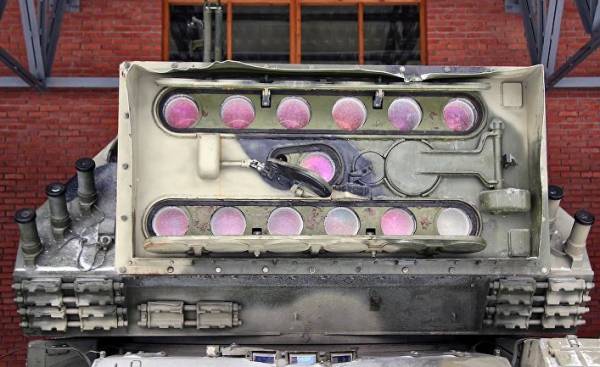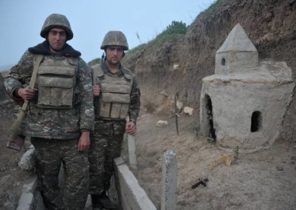
After more than fifty years the United States military, finally close to starting to supply the armed forces with the laser weapons to defend against missiles, drones and small vehicles. However, the Soviet Union, too, in decades of doing research in the field of laser weapons, and have developed an amazing variety of such devices, ranging from laser guns, three tanks and ending with the laser equipped with a laser gun space ship.
The laser system transform the photons (particles of light) in a coherent beam, and although most military lasers are currently used for targeting and measurement of distance and so on, a sufficiently powerful laser can create destructive thermal energy storage. Depending on the type of lasers are able to project visible or invisible rays — the latter typical of most combat lasers, although the point where the laser beam is likely to be well marked.
In theory, laser weapons can be extremely accurate, fast — difficult to compete with the speed of light — and cheap in comparison with missiles or artillery shells. However, until recently it was considered impractical because of the large power plants and the necessary cooling systems, and also due to their limited range and problems with defeat well-protected targets.
The Soviet Union began experimenting with laser weapons in the 50-s and 60-ies. His first laser battle stations, which appeared in 70-ies, was stationary ground-based systems, with appropriate sci-Fi names — “Terra-3” and “omega”. The installation “Terra-3” includes two different instrument, and she was placed on the testing ground Sary-Shagan in Kazakhstan, a visible red beam and an invisible laser on the carbon dioxide. Initially the installation “Terra-3” was developed in 60-e years to defeat ballistic missiles in the final phase of reduction, but then, in 1972, an agreement was signed, prohibiting the development of systems to counter ballistic missiles, and it had been reoriented to the fight against orbiting satellites, although much success was not achieved because of inaccurate tracking system.
However, the installation “Terra-3” has forced the Pentagon to say in the 1980-ies about the potential Soviet “advantage in the field of lasers” on American technology, and former Soviet officials even spread rumors (today they are all refuted) that in 1984 was highlighted in the space Shuttle Challenger, which emerged as a result of problems in the control system. Later, however, when conducting foreign specialists of the inspection it was found that this laser system was only a prototype, does not have the required capacity and scale for significant impact on the orbital targets.
Developed parallel to the laser system the omega was designed to engage aircraft and missiles in the atmosphere. System “omega-1 and omega-2” was more successful in terms of defeat distant targets, but they still lacked the impact force and energy capacity.
However, laser installation “omega”, according to experts, became the basis for the development of Russian ground-based air system. It is not easy to develop an effective terms of power consumption, the laser is able to project to the far distance of your beam, and maybe the solution was just to reduce the distance to the target. In 1984, Soviet scientists developed a laser gun in the style of the outfit buck Rogers (Buck Rogers), and he therefore intended for use by Soviet cosmonauts. Presumably, he had used to incapacitate optical devices on the Western satellites, as well as to blind hostile astronauts, while not causing damage to the hull of a spacecraft. Each time you press the trigger has been activated pyrotechnic cartridge flash lamp in a container, consisting of six compartments.
An additional positive point was that this kind of laser guns can be used as a medical scalpel, which was conjure up a creepy picture of a makeshift space surgery in the style of Prometheus. But that’s not all: there was also the option of laser gun that was almost too incredible for the movie “Star wars”, but was a good fit for the Soviet Arsenal.
However, these laser guns has caused only minor damage — one and ten joules of energy, equivalent to the pneumatic gun, and the actual range was only 20 meters. This project was stopped at the stage of prototyping, and therefore, the Soviet cosmonauts were forced to settle for a triple barrel gun-TP-88 — it was a non-automatic shotgun with a built-in gun of caliber of 5,45 millimeters, and with a folding machete.
Laser guns were not designed for use on the battlefield, can not be said about the Soviet laser tanks. The initial tank 1К11 “Stiletto” was equipped with a single laser emitter, and its range was from five to seven kilometers. Then he was replaced by a heavier tank 1К17 “Compression”, work on which was completed only in 1992, after the collapse of the Soviet Union, and he was placed on the same armoured chassis and self-propelled howitzer 2S19. This terrible beast had two containers with six laser emitters in each, and was reminded of mechanized Argus, borrowed from a mythological past. And the name was appropriate, since 12 multichannel laser tank “Compression” needs to be focused into one beam, and their task was not to destroy, but to blind enemies, that is to disable the superior quality of optical instruments, camera and guidance systems of tanks of the NATO countries.
However, the tank 1К17 demanded many victims who were worthy of thirsty gods — 30 kilograms of synthetic rubies were necessary for the terminals in each of the 12 lasers! Although the range of this laser could theoretically exceed the actual range of the guns of those tanks that he had to fight the Russian military probably saw little reason to adopt a special armored vehicle to suppress a tank optics, as instead it is possible to place anti-tank missiles.
However, smaller “blinding laser”, as far as we know, is installed on 99 Chinese tank, which theoretically allows him first to blind your enemies and then hit them from the main gun. Overall, however, “blinding lasers” was originally thought to cause damage to the eyesight of soldiers that are prohibited under the 1995 Protocol on blinding laser weapons. In any case, in 2015, “Rossiyskaya Gazeta” suggested that the Russian engineers started to develop a new laser tank.
The third Soviet laser tank was the “Sangvin”, a laser was mounted on the chassis anti-aircraft gun ZSU “Shilka”. Instead anti-aircraft gun on the chassis on its rotating turret was mounted laser emitter, like a spotlight. Established in 1983 tests showed that “Sangvin” was capable to disable the optics of enemy aircraft at a distance of from eight to ten kilometers.
Of course, in the 1980-ies it was not only Councils worked to develop laser weapons. According to reports, the United Kingdom had placed on one of their ships blinding laser for use during the Falkland war (prior to the application of the case never came). As for the United States, one of the notable proposals for “Star wars” President Reagan and his Strategic defense initiative was the use of units equipped with laser satellites to destroy enemy ballistic missiles, which ultimately should lead to the creation of a missile defense shield.
This is the opportunity to create on satellites defense shield has motivated the development in the Soviet Union of its own equipped with lasers “orbital weapon platforms” called “pole” (in fact, it was about creating a deserted space station) in order to shoot down American satellites — though the word “down” we don’t have to imagine something like a violent fight between the fighters of X-wing and TIE from “Star wars”. Rather, it will be like a remote invasive surgery using lasers. Mounted on a “Pole” huge megawatt laser on carbon dioxide is not necessarily needed to destroy their target. He could have the ability to burn optical control system on the Western defensive satellites, depriving them thus of the ability to fix the start of the Soviet missiles in a first strike.
However, hastily built a prototype of the spacecraft “SKIF-DM”, mounted on a powerful carrier rocket “Energy”, failed to reach orbit due to poorly tested an inertial control system. This 90-ton spacecraft fell into the South Pacific ocean, and therefore this initiative, in the end, have been buried under the water. However, there is one more secret — like incidents with spacecraft wasn’t enough, bound with lasers on Soviet warships. In October 1987, the Pentagon has complained that one of its Maritime patrol aircraft P-3 Orion “was illuminated by intense light,” whose source was on the Soviet ship. Western military intelligence at the time was sure that the heavy cruiser “Kirov” had its own blinding laser combat, however, convincing evidence of this is still there.
In any case, in 1984 the Soviet Union launched a test model of the ship “foros” laser unit “Aquilon” intended for disabling optical guidance devices and crews of enemy ships. Although this laser, as reported, during the tests showed its effectiveness in the fight against flying over the sea surface missiles, it was able to destroy targets at the distance of 4 kilometers, and its output power was only 5%.
Now that ends the case with space vehicles, marine vessels, tanks and astronauts, there are only planes. In 2000 years the Pentagon has spent $ 5 billion to develop the project YAL-1 — this was a huge plane placed in the bow of the laser, which has successfully shot down in flight ballistic missiles — but its range was insufficient to enable it to effectively use. Maybe the plane YAL-1 will no longer fly, but his more senior colleague, the Russian Beriev A-60 is still flying today. A modified heavy transport aircraft Il-76MD made its first flight in 1981, and three years later he began to participate in the testing laser weapons on Board. Laser range finder such as lidar, mounted in the bow, helps to direct the primary gas laser based on carbon dioxide located in its cargo hold, and defeat the purposes of going through the blister protrusion on the fuselage.
The gondolas on both sides of the fuselage are arranged the turbine generators required for operation of the two lasers. The power of the main laser reportedly can reach one or two megawatts, and the range can be 110 kilometers.
Information regarding testing of the aircraft A-60 a bit, and most of it is classified, but one can assume that the lasers on Board are used to blind satellites in low orbits. In addition, as reported, it was used to illuminate Japanese satellite in 2009. Although the first Soviet laser plane burned during a fire at the airport in 1989, the second A-60 aircraft, which was completed in 1991, continues to pass the test with the new laser 1ЛК222.
It is clear that the legacy of the Soviet laser weapons and today continues to be with us. Although it is unlikely that laser guns will be used during the conflict at the International space station, a Soviet prototypes continue to evolve, and the resulting technology can be used for disabling the control systems and optics, drones and satellites. It is this potential arms race and the development of systems for the destruction of the orbital spacecraft must be carefully reviewed by international leaders — let’s hope that this will avoid amplification of this trend.







